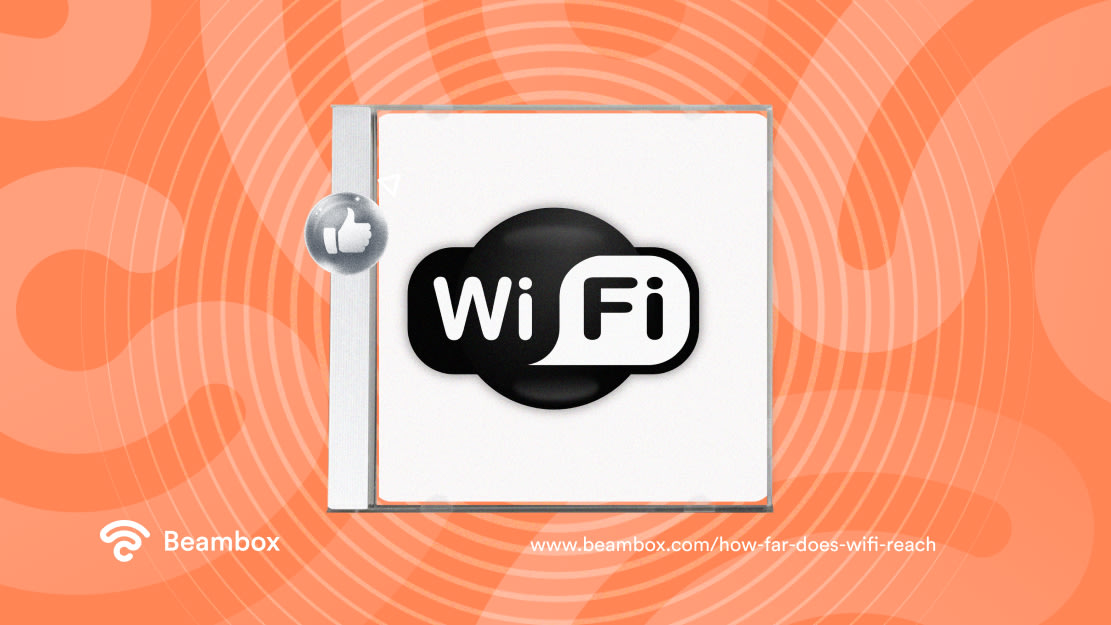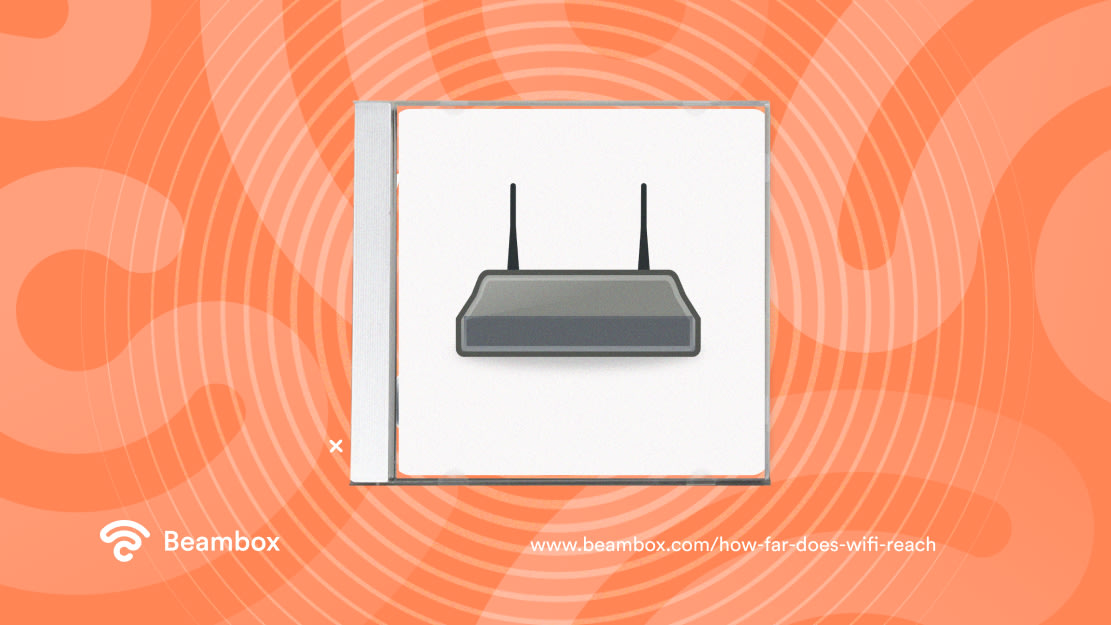How Far Does WiFi Reach: Picking the Best Business WiFi
Answering the question “How far does WiFi reach?” depends on many factors, including signal strength, ISP, and router quality. And that’s without even factoring in the layout of your business or property.
Things like walls, doors, and floors all impact how far your WiFi reaches. For example, there’s a massive difference between how far WiFi travels in single-floor and multi-story buildings.
In short, this is a loaded question. However, we’ll walk you through the process. Once you know the basics, you’ll be able to optimize your WiFi range with ease. Understanding what factors impact your WiFi’s range is important so you can really get the most out of your network.
In this guide, we’ll define the jargon phrases, teach you about WiFi extenders, and analyze 2.4 GHz vs. 5 GHz. There’s lots to cover, so let’s make a start. Here’s what you need to know about how far WiFi reaches.

What Is WiFi Distance Range?
Your WiFi distance range is how far your WiFi can reach. The further it reaches, the fewer dead spots you’ll have.
For instance, a far-reaching WiFi network will provide coverage across your whole property. On the other hand, a short-reaching WiFi network leaves some areas without coverage, so you can see why people care.
In general, most residential routers give you a WiFi range of around eight meters. This range distance goes in all directions: up, down, and sidewise.
However, a few different factors can impact this further. The question of “How far can WiFi reach?” doesn’t just factor in the general range. Here’s what you should consider:
- Physical obstacles, like walls, floors, and doors.
- Frequency bands, including 2.4 GHz versus 5 GHz and Bluetooth versus cellular.
- Signal strength, which often depends on your provider.
- Interference, like other users on a crowded channel.
- The router’s antenna (directional antennas vs. omni-directional antennas).
- Your actual device and its suitability and efficiency when connecting to WiFi.
As you can see, it isn’t as simple as finding wireless standards when researching “How far does wireless internet reach?”.
You must know that range incorporates all those other factors, be it router antennas, physical obstacles, or frequency bands.

How Far Does a WiFi Extender Reach?
On average, a WiFi extender can add up to 30 meters to your WiFi range. This is incredible, almost tripling your initial coverage.
WiFi extenders are clever equipment that work in a special way. Some work wirelessly, and others plug into sockets. They pick up your original WiFi signals, rebroadcasting them from a different location to spread out your coverage.
Of course, asking “How far does a WiFi extender reach?” also involves considering factors like obstacles and interference. But as a general rule, you can guarantee at least double your initial WiFi coverage.
When placing your WiFi extender, you should always consider the following three factors:
- Where you place your extender.
- Where your dead zones are and your overall goals.
- Your budget.
Where you place your extender and how tactically you do so will massively dictate how much extra range you get. Similarly, knowing your budget means you can always invest in Mesh WiFi instead if WiFi extenders alone don’t solve it. Mesh WiFi has lots of different nodes, meaning it can spread further.
How Far Does 2.4 GHz WiFi Reach?
2.4 GHz WiFi has a potential reach of 46 meters. But what’s really important is clarifying what exactly you can expect from this frequency band. It isn’t just as simple as asking, “How far does 2.4 GHz WiFi reach?”
2.4 GHz offers slower speeds but larger distances, making it perfect for covering large properties with fewer users. It can penetrate obstacles like walls and doors much more easily and provide great property-wide coverage. 2.4 GHz is usually great for residential properties. That is unless you have multiple people streaming data or working from home.
The more people using 2.4 GHz WiFi, the slower it will be. Since it is already quite a slow frequency option, that can make it lag. This type of WiFi is also susceptible to interference, which is when multiple users can disrupt the signal.
In short, 2.4 GHz is great if you want an average but wide WiFi reach. However, we wouldn’t recommend it for a business, as it’s likely going to be too slow when many customers go online.

How Far Does 5 GHz WiFi Reach?
5 GHz WiFi has a much shorter reach of around 23 meters. But like 2.4 GHz WiFi, there are some extra things to consider when asking, “How far does 5 GHz WiFi reach?”
First, 5 GHz WiFi offers faster speeds over a much shorter distance. Because of this, it is ideal for small areas with lots of users, such as cafes or restaurants. 5 GHz is also way more likely to experience interference, which is another reason it is so well-suited to business environments.
Most businesses operate in small areas, so 5 GHz is our top recommendation for customer WiFi. If you operate a business in a large area, like a hotel, you should look into Mesh WiFi or extenders.
So, when people ask, “How far will WiFi reach?” you can see how it varies.
It isn’t a case of one frequency band being all-round better than the other. It massively depends on how much you value signal strength versus range. Simply put, deciding between 2.4 GHz and 5 GHz is an argument that requires nuance.
Overall, though, it’s simple: the best wireless network is the one that suits you and your requirements.

Beambox: How Far Does WiFi Reach for Customer Use?
When running a business, whether a shop or hotel, you want good WiFi ranges for your customers. The more dead spots you have, the worse your customer experience. And if you have a large business property, you’ll need WiFi that covers a lot of distance.
While the general rule is 8 meters, with proper extenders or Mesh WiFi, you could increase that to 40 meters. That should be enough to cover even the largest of business venues. If you’re still unsure how to increase your WiFi reach, you can contact your ISP for guidance.
At Beambox, we fine-tune your WiFi once you establish the basics. The bare minimum for business WiFi is adequate reach and signal strength. However, the best WiFi networks for businesses also feature captive portals.
We offer a top-of-the-range captive portal system that collects valuable details from your customers in exchange for WiFi access. This way, they get WiFi, and you get marketing contacts like email addresses and phone numbers.
Start your Beambox free trial today and embrace better WiFi for your customers and yourself. It isn’t all about “how far does WiFi reach”; it’s about how to use WiFi to improve and grow your business. We can make Beambox work for both of you.
Get Started With Free WiFi Marketing
Beambox helps businesses like yours grow with data capture, marketing automation and reputation management.
Sign up for 30 days free


